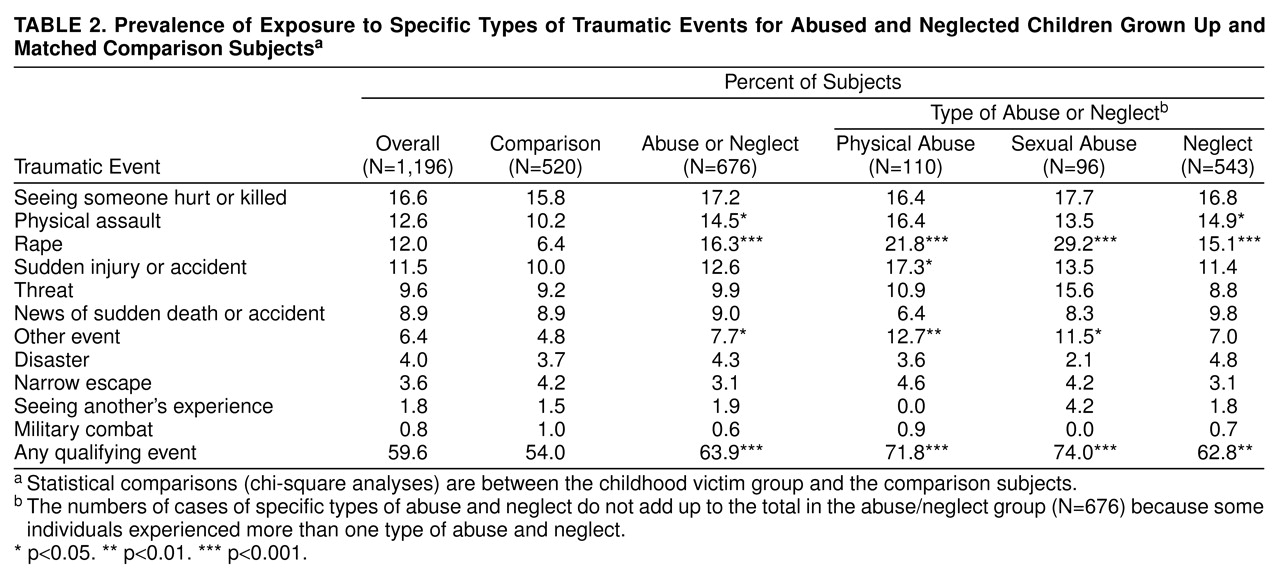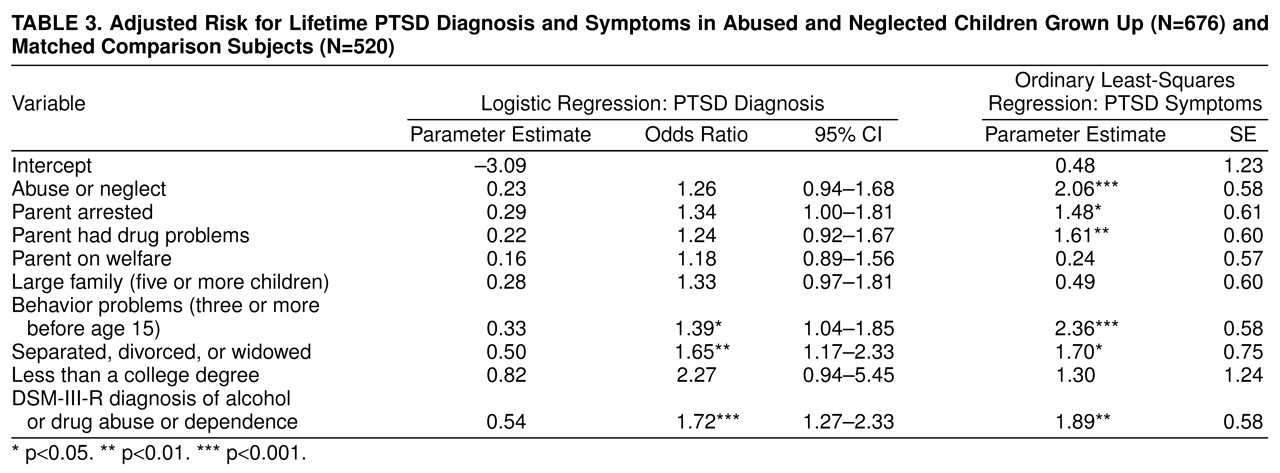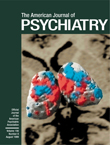Subjects
The data for the present article are from a large research project based on a prospective cohorts design study
(25,
26). Abused and/or neglected children were matched with nonvictimized children and followed prospectively into young adulthood. The prospective nature of this study allows some issues of causality to be examined and helps to disentangle the effects of childhood victimization from other potentially confounding effects. Because of the matching procedure, the subjects are assumed to differ in the risk factor (that is, having experienced childhood sexual or physical abuse and/or neglect). Since it is not possible to randomly assign subjects to groups (and obviously, this could not be done), the assumption of equivalency for the groups is an approximation. For complete details of the study design and subject selection criteria, see Widom
(27).
In the first phase of this research, a large group of children who were abused and/or neglected approximately 20 years earlier were followed up through an examination of official criminal records and compared with a matched group of children
(28). The abused and/or neglected group was composed of victims of substantiated childhood physical and sexual abuse and/or neglect whose cases were processed during the years 1967 through 1971 in the county juvenile or adult criminal court (situated in a metropolitan area in the Midwest). These are cases of early child abuse and/or neglect, restricted to children who were 11 years of age or less at the time of the abuse or neglect incident.
Physical abuse cases included injuries such as bruises, welts, burns, abrasions, lacerations, wounds, cuts, bone and skull fractures, and other evidence of physical injury. Sexual abuse cases varied from those involving relatively nonspecific charges of “assault and battery with intent to gratify sexual desires” to more specific ones of “fondling or touching in an obscene manner,” sodomy, incest, and so forth. Neglect cases reflected a judgment that the parents’ deficiencies in child care were beyond those found acceptable by community and professional standards at the time. These cases represented extreme failure to provide adequate food, clothing, shelter, and medical attention to children.
A matched comparison group was established. Children who were under school age at the time of the abuse and/or neglect incident were matched with children of the same sex, race, date of birth (within 1 week), and hospital of birth through the use of county birth records. For children of school age, records of more than 100 elementary schools for the same time period were used to find matches with children of the same sex, race, date of birth (within 6 months), same class in same elementary school during the years 1967 through 1971, and home address. Overall, there were matches for 74% of the abused and neglected children.
The second phase of the research involved the tracing, locating, and interviewing of the abused and/or neglected individuals (20 years after their childhood victimization) and comparison subjects. Two-hour follow-up interviews were conducted between 1989 and 1995. The interview consisted of a series of structured and semistructured questions and rating scales, measures of IQ and reading ability, and a psychiatric assessment.
Interviewers were blind to the purpose of the study, to the inclusion of an abused and/or neglected group, and to the participants’ group membership. Similarly, the subjects were blind to the purpose of the study. Subjects were told that they had been selected to participate as part of a large group of individuals who grew up in the late 1960s and early 1970s. Subjects who participated signed a consent form acknowledging that they were participating voluntarily.
Of the original group of 1,575, 1,307 subjects (83%) have been located and 1,196 (76%) interviewed. Of the people not interviewed, 43 were deceased (before interview), eight were incapable of being interviewed, 268 were not found, and 60 refused to participate (a refusal rate of 3.8%). The findings reported here are based on 1,196 subjects (676 abused and/or neglected and 520 comparison subjects).
Comparison of the current follow-up group with the original group indicated no significant differences in terms of percent male, white, abused and/or neglected, poverty in childhood census tract, or mean current age. The interviewed group (follow-up group) was significantly more likely to have an official criminal arrest record than the original group of 1,575 (50% in the current group versus 45% in the original group; z=3.9, p<0.01). However, this is not surprising, since people with a criminal history are generally easier to find, in part because they have more “institutional footprints” to assist in locating them.
Approximately half the group (48.7%) were women, and about two-thirds (62.9%) were white. At the time of interview, the average age of the participants was 28.72 years (SD=3.84, range=18–40). There were no differences between the abused and neglected group and comparison subjects in terms of gender, race/ethnicity, or age. The average highest grade of school completed for the group was 11.47 (SD=2.19, range=5–26). The group is skewed toward the lower end of the socioeconomic spectrum. The median occupational level
(29) for the group was semiskilled workers, and less than 7% were in levels 7–9 (managers through professionals).




